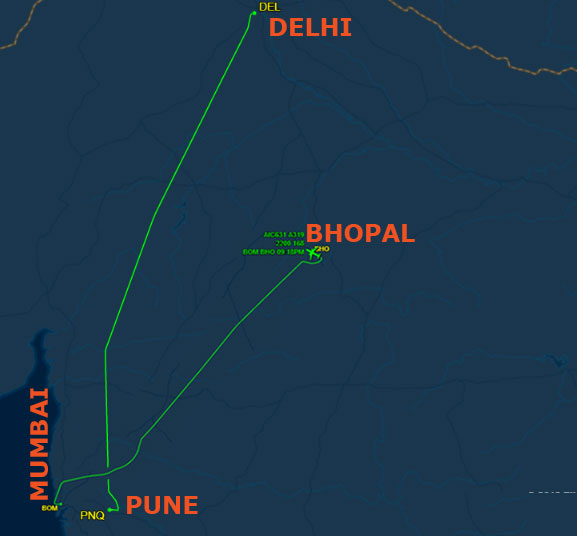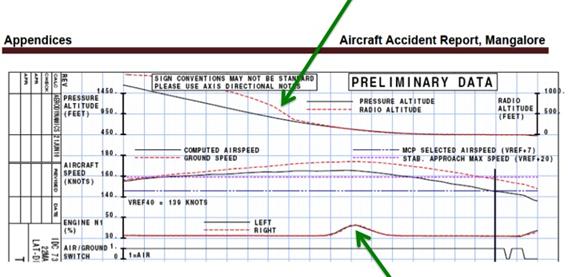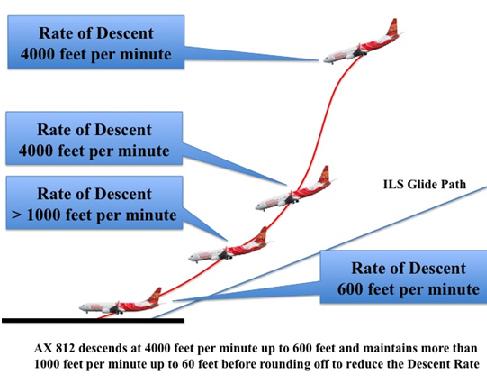By Jacob K Philip
A near miss incident involving a Vistara Delhi -Pune flight and an Air India Mumbai-Bhopal flight could be one of the most discussed and widely reported aviation incidents recently in India. Though the report that was carried first by Times of India on 11th of this month and later taken up by most of the national and regional press has brought aviation safety to sharp focus again, it raises more questions on how safety issues like this are reported and interpreted by the media.
And it is also of concern that the whole details of the incident were leaked to the press by one or two central government organizations and the press thereafter presented it to the public in the most unprofessional and unethical manner.
The is a gist of the report(s):
On February 7, night an Air India flight (Mumbai to Bhopal AI 631, an Airbus A 319-112) was travelling at 27,000 ft towards Bhopal. A Vistara flight (UK997, Airbus A320-251N) that was inn the same skies flying towards Pune from Delhi at 29,000 feet suddenly started descending to 27,000. The astonished area controller asked the Vistara why it left the assigned level of 29,000 and going to 27,000 and the pilot of the craft retorted that she was told by the controller to do so. The argument was heard by the AI pilot too, because She too was tuned to the same frequency. Then to her horrors, the AI commander noticed the Vistara flight speeding towards her flight just 2.8km away. Then the Traffic Collision Avoidance System (TCAS) of both the aircraft issued a very urgent collision warning (resolution advisory). The warning said, “climb, climb” to the AI flight and the pilot climbed up and turned right immediately to fly clear of Vistara, to escape the doom that was imminent. The level difference between two flights was just 100ft before AI flight climbed up, as per TCAS. When their paths crossed each other , the level difference was just 600ft. Whereas, the allowed minimum vertical separation was 1000ft.
The original reports published by the Times of India on two consecutive days and the rehash of those reports by the rest of the national media made the readers think that:
- The two aircraft were traveling in opposite directions
- Both aircraft were maintaining their respective levels- 27,000 and 29,000 feet – cruising along peacefully until the Vistara started descending from 29,000 to AI flight’s 27,000 level.
- It was the presence of mind Air India pilot that saved the lives of as many as 271 people on board of both aircraft. She acted precisely and swiftly when faced by a life threatening eventuality.
- But for the AI pilot, the two aircraft would have collided each other, face on.
But the actual facts couldn’t have been more different:
- Direction of the fights: The aircraft were not traveling face to face towards each other. At the time of conflict, the angle made by the flight paths of two aircraft were apporx 120 degrees – not 180. See the picture.
- No level flight: After taking off at 7.40 PM from Mumbai airport, the Air India aircraft was still in the climbing phase of the flight (It had to reach the cruising altitude of 33,000ft within a few minutes) and so it was gaining around 1000-1500 feet per minute, consistently.
And the Vistara flight, that had left Delhi 6.50PM was steadily losing altitude for a landing at Pune airport at 8.52PM.
Bothe aircraft were NOT staying at any particular altitude. One was climbing, the other was descending.
See altitudes of Air India flight 631 was maintaining before and after the incident (From 23,600 to 28,300 ft) (Log from flight tracking site Flightaware).
- At 08:28:23pm 23,600ft
- At 08:28:54pm 24,600ft
- At 08:29:24pm 25,100ft
- At 08:30:01pm 25,800ft
- At 08:31:00pm 27,200ft
- At 08:31:40pm 27,400ft
- At 08:32:40pm 27,800ft
- At 08:33:07pm 28,300ft
And these were Vistara flight’s levels :
- At 8:28:18pm 31,500ft
- At 8:28:49pm 31,000ft
- At 8.29:19pm 30,200ft
- At 8.29:49pm 29,300ft
- At 8.30:19pm 27,800ft
- At 8.30:49pm 27,000ft
- AT 8.31:38pm 26,600ft
- At 8:32:09pm 26,600ft
- At 8:32:43pm 26,800ft
So here we have two flights traveling at two level s heading to two destinations and whose flight paths were to be crossed at some point of time. And just as it was the only logical step, the descending aircraft was told by the Mumbai Area Control to stay above and the climbing one to stay below, so that they could be allowed to pass each other at the first safest point of time when the vertical and lateral separation between the two was safest.
And to repeat that again, it was only natural for the Vistara flight to climb down sooner or later.
- The pilot who braved odds to save lives?
Not really. The pilots of both the aircraft were just obeying the orders issued by the computer of TCAS of their respective aircraft. The AI commander climbed up because the TCAS decided that was better and ordered her to do so. Just like the Vistara co-pilot, who lowered her aircraft as per the TCAS command. And there was nothing marvellous in these actions either. All the pilots are thoroughly trained to do that and they are bound to follow the exact procedure. And the decision maker is not the pilot, but the TCAS computer. The course of action is decided collectively by the TCAS computers of both the planes after assessing the speed, altitude, mode of flight and bearing of both the planes. And when the computers issue the verbal command ( to climb or to descend, mostly) the pilots have no choice but to obey blindly. - A certain doom scenario? The chances of a collision was less, though the TCAS had ordered the pilots to climb/descend immediately. Even if the planes were proceeded in the same levels maintaining the same speed, the chances of actual collision were remote.
See the pictures that show the full flight paths of the aircraft and the enlarged view of the point where the Resolution Advisory was given by the TCAS around 8.30pm, 7th February.
One aircraft was at 27,000ft and the other was at 27,100ft altitude. The speed of the Air India flight was 1080km/hr. The Vistara flight was covering 763 km in an hour. The lateral separation between the flights was 2.8km. The bearing of Vistara flight was 177 degrees and that of AI was 74 degrees, approx.
If we draw two lines extending the path of both the aircraft, it can be seen that they would cross each other at a distance of 2km (down) from the present position of Vistara fight. To reach that point, the time taken by Vistara would have been 9 seconds. But during those 9 seconds, AI flight would been moved 3.9km away from its present position.
So there were no collision going to happen.
But then what about the TCAS urgent warning? Can computers go wrong?
The computers of course were not wrong. Only that, these systems always incorporate a factor of safety in all calculations. An extra allowance will be added to all the distances and heights. And that is how it should be.
The Area Controller factor
In the sensationalized report of Times of India, this character got only a passing mention – but that was damaging enough. According to the report, the AC was taken by surprise ‘seeing’ the Vistara fight at level 271. The question the AC reported to have asked the Vistara pilot – “why are you here?”- betrays his total lack of control over his job. A person constantly monitoring the flight can’t be taken off guard like that. So he indeed was a villain, though not the main one, in the story.
The main villain and the heroine
And about the main one, there were enough ingredients- lucky for the reporter- to spice up the whole thing: the co-pilot was a woman; she was alone; her Commander was not anywhere near at the critical moment. A young, in experienced, ignorant girl of a pilot left alone to find her way out of the mess she had made was the perfect dark background for the heroine of the story.
And what a heroine it was to be !
– A mature, elegant woman in her late forties with 20 years of flying experience under her belt, the Air India commander was the perfect picture of the cool, composed superwoman who averts imminent disaster at the nick of time.
So we have the day-two story:
Near miss: How AI’s woman pilot saved lives of 261 flyers
And it will be highly inappropriate to end this note without mentioning an effort actually made by the ToI reporter to guess why there was a ‘confusion’ between the Vistara flight and the AC.
” There may have been confusion between the ATC and Vistara cockpit — which at that time had a woman co-pilot at the controls and the captain had taken a toilet break. The AI flight had a woman commander, Captain Anupama Kohli. Maybe there was a mix-up in communication in those tense seconds like what altitude instruction is being given to which lady. This has to be seen,” said sources.”
So the assumption is that the AC got confused between the two woman voices. It is sad that the reporter didn’t pause for a second to think about the numerous male voices an AC hears throughout the day from the cockpits of so many flights, without confusing among them. Before writing down this silly guess, the reporter should have tried to understand a basic norm too of radio communication : Before the start of each instruction, the controller has to spell the call-sign of the aircraft he is giving the instruction. And when the pilot replies, she/he also has to say his call-sign at the end of his words. And above all, the aircraft is constantly being monitored visually on the radar screen, by the AC at the Area Control.
The leak
How the details of the incident found their way to the media is intriguing, to say the least.
In both the reports, there were details that were known only to the people directly involved in the incident and to the officials of DGCA who had received reports from the parties involved – the facts that the Vistara co-pilot and Air India commander were women and the Vistara male commander was taking a toilet break during the incident are examples.
The AC , AAI and the Vistara crew would not have leaked the info, for obvious reasons. The remaining parties are the Air India crew and the DGCA. Given the heroine status given to and readily accepted by its senior pilot, Air India of course is the chief suspect. And they couldn’t have done that alone. The other half of the story unfolded the night of 7th February aboard the Vistara flight must have been filled in by someone who had access to the report Vistara sent to the DGCA.
But why?
Why should someone from Air India and/or DGCA take the pains to give these details to the press? Not for the sake of air safety, that is obvious. If that was so, the report would have been much more accurate and the day-two story glorifying the AI commander would never have happened.
The ongoing investigation by Aircraft Accident Investigation Bureau will serve its purpose fully only if the answer to the above legitimate question too is found out.















